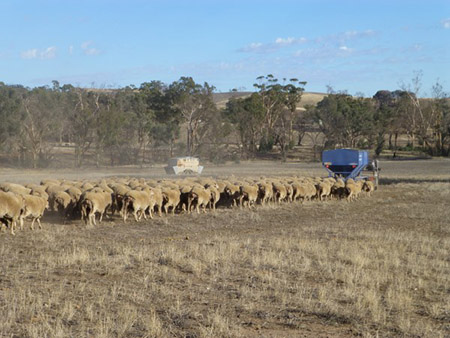Planning for 2019 should be front of mind for all producers. The 2018 season showed the extremes across SA with both drought and a bumper season occurring. It is important to review your current business position given 2018. What are the critical decisions that need to be taken, particularly if the 2019 season is poor?

Whilst stocking rate is a key driver of profitability, it is important to ensure that it is managed to the season. The break to the season is a key factor influencing carrying capacity. So determining trigger points (i.e. dates and strategies), can allow stocking rates to be optimised whatever the season. It is particularly important to have a well-developed “exit” strategy for late or poor breaks to the season.
Carrying capacity should be manipulated relative to the season break. Table 1 provides an example of the impacts of time of the opening rains on carrying capacity. Trigger points (i.e. critical dates) should be established for your own situation. The trigger points are dates at which actions must be implemented.
Table 1: Impact of time of opening rains on livestock carrying capacity
| Break of season (Date) | Potential Stocking Rate (DSE/winter grazed ha) | Planned Stocking Rate (DSE/winter grazed ha) |
| 1 May | 11 | 8 |
| 7 May | 10 | 8 |
| 14 May | 9 | 8 |
| 21 May | 8 | 8 |
| 28 May | 7 | 8 |
| 4 June | 6 | 8 |
| 11 June | 5 | 8 |
| 18 June | 4 | 8 |
- Maintain carrying capacity
- Reduce feed demand
Table 2: Tactics to manage livestock with a late or poor break to the season
| Tactics | Outcome |
| That maintain carrying capacity | |
| Increase supplementary feeding | Maintain stock condition- sustain flock production, reproduction and sale value |
| Purchase extra feed early | Obtain feed at a reasonable price and ensure sufficient feed available |
| Reduced crop- increase pasture | Reduced winter stocking rate but less stubble area to graze in summer / early autumn |
| Put stock in containment areas | Preserve ground cover, protect top soils, defer graze pastures to increase leaf area and growth |
| Apply nitrogen fertiliser to pastures | Increase early growth and vigour of grasses |
| Growth promotants on pastures (Gibberellic Acid) | Increase winter and spring pasture growth |
| Control pasture insects | Increase winter and spring pasture growth |
| Graze crops | Defer graze pastures, reduce supplementary feeding |
| Strip grazing | Increase winter and spring pasture growth |
| Rotational grazing | Increase winter and spring pasture growth |
| Early weaning | Maintain ewe condition to reduce the chance of carry over effects to next joining |
| That reduce feed demand | |
| Pregnancy scan and sell dry stock and culls | Reduce stocking rate, maintain core breeders |
| Agistment off-farm | Reduce stocking rate at home but maintain flock size for when the season breaks |
| Early stock sales | Ensures surplus sheep don’t consume summer feed reserves- leaving more for core flock |
In seasons where winter rainfall is below average, stored soil moisture coming into spring will be low and pastures may struggle to grow rapidly as temperatures begin to increase. Table 3 provides an example of the impact of dry winter/spring on livestock carrying capacity. Trigger points should be established for your own situation/district.
Table 3: Impact of dry winter/spring on livestock carrying capacity
| Date | Climate outlook Chance of above median | Potential Stocking Rate (DSE/winter grazed ha) | Planned Stocking Rate (DSE/winter grazed ha) |
| 1 Aug | < 40% Aug-Oct | 11 | 8 |
| 7 Aug | < 40% Aug-Oct | 10 | 8 |
| 14 Aug | < 40% Aug-Oct | 9 | 8 |
| 21 Aug | < 40% Aug-Oct | 8 | 8 |
| 28 Aug | < 40% Sept | 7 | 8 |
| 4 Sept | 6 | 8 | |
| 11 Sept | 5 | 8 | |
| 18 Sept | 4 | 8 |
Tactics for these seasons may include:
- Bringing forward the sale of sheep - such as cast-for-age ewes or surplus young sheep
- Establishing a containment area to preserve the soil-pasture resource
- Early weaning - lambs can be weaned at 8 to 10 weeks of age with access to high quality feed
- Purchase extra feed early
- Seek agistment early.
For further information talk to your Livestock Consultant.





